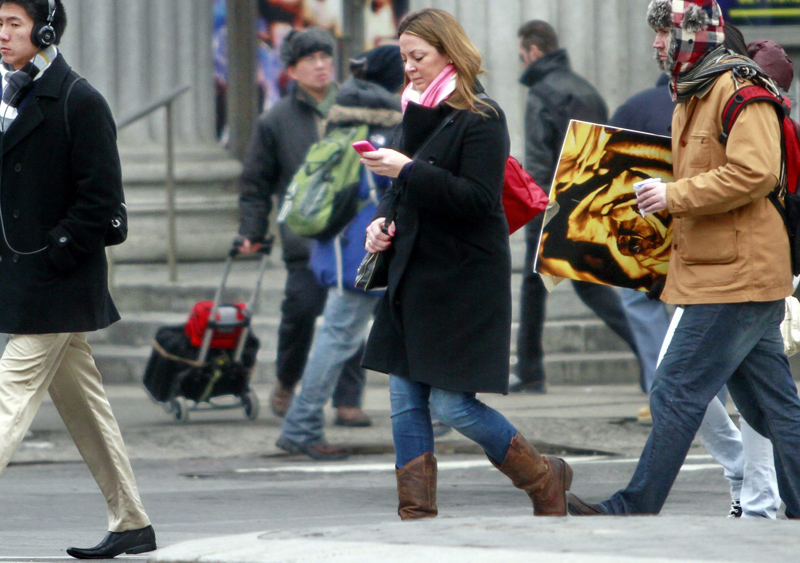As cellphones became more common in the early 2000s, one thing became clear — they mix badly with driving. Within a few years of each other starting in 2009, most provinces passed laws banning drivers from using cell phones, and especially texting, while driving. The laws were a response to a series of tragic, preventable accidents.

Jurisdictions across the developed world passed similar laws.
Not surprisingly, the rise of mobile devices shows up in accident statistics. In Ontario, more and more drivers every year who are hurt or killed in collisions are reported to have been ‘inattentive’ at the time of the collision. (Similar data wasn’t available for B.C. or Alberta.)
In a police accident report, a driver being ‘inattentive’ can mean any number of things: fiddling with a radio, eating breakfast, dealing with bored children. Many things could distract drivers, but the only thing that’s changed in the last generation or so is the rising use of mobile devices, which insist on taking up a driver’s attention when it really belongs on the road.
“It absolutely has to do with mobile devices inside vehicles and people using them when they’re driving,” says Toronto-based personal injury lawyer Patrick Brown.
“In my line of work, I do believe that there’s a definitive increase because of that.”
(Ontario’s distracted driving law, which took effect in 2010, appears to have no effect on the graph above, but it’s impossible to know whether there would have been more accidents without it.)

Get weekly health news
READ MORE: Toronto car crashes: More distracted drivers, fewer drunk ones
What about pedestrians? It’s not hard to find someone blundering down a sidewalk while texting, and YouTube offers a chance to watch people busy with their devices not noticing a bear, toppling into a shopping mall fountain, or falling off a pier. (Here’s a compilation.)
But do distracted walkers show up in the accident statistics? Not so you’d notice.
At the gentle speed of a normal walking pace, we can afford to multitask, while at higher speeds, we can’t, argues Toronto pedestrian activist Dylan Reid.
“We are completely designed to be able to do many things while we walk, moving at a walking speed. It’s how we evolved.”
“We are incredibly good at avoiding each other. On a crowded sidewalk, somehow everybody manages to dodge and avoid each other. And not especially because we’re paying attention — we may be talking to each other as we do it, we may be browsing shops as we do it.”
“We’re not adjusted to multitasking at higher speeds — cycling speed, or driving speed. That’s when distraction becomes a problem, because we can only pay attention to a limited number of things at a time.”
In Toronto, pedestrian collisions where the pedestrian was coded as inattentive have fallen since 2005, figures released by the city to Global News show. A report by the city’s medical officer of health showed that only 13 per cent of pedestrians hit in the city were inattentive for any reason.
“The difficulty is, with cars, what they represent, based on their speed, their size, their weight,” Brown says. “If you are handing a weapon, you handle it with care. You can’t have distractions, you can’t have multitasking — you’ve got to have one hundred per cent of your cognitive ability.”
New Jersey recently considered a law banning texting while walking. The American Academy of Orthopedic Surgeons recently launched a campaign against distracted walking — in which they included talking to other people while walking.
But in a recent experiment at the University of Bath in England, people asked to text while they walked through an obstacle course naturally slowed down, took their time, and didn’t trip or hit an obstacle.
“Our results … suggest that those who walk and text adopt a “protective” gait pattern alteration in order to minimize the risk of potential accidents,” the scientists wrote.
At a pedestrian speed, Brown says, a normal sense of self-preservation has a chance to operate, even if walking doesn’t have your full attention.
“We know that there’s an inherent self-deterrence built into our system, that if I step off that curb, there is a likelihood that I will be either very seriously injured or killed. From a very young age we have a built-in deterrent system of self-preservation that exists with all of us.”
Is it a good idea to wander around distracted by a tiny keyboard? Not really. But 20 years of accident data seems to tell us that it doesn’t belong on a list of big problems, either.
Thu, Jul 30: According to a UK study, people are more likely to have trouble walking while texting and that annoys people around them. Nicole Bogart reports.



Comments